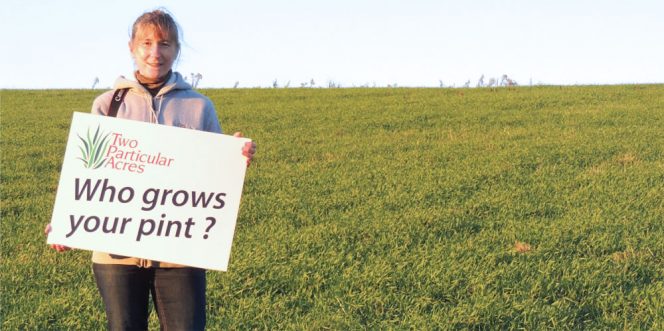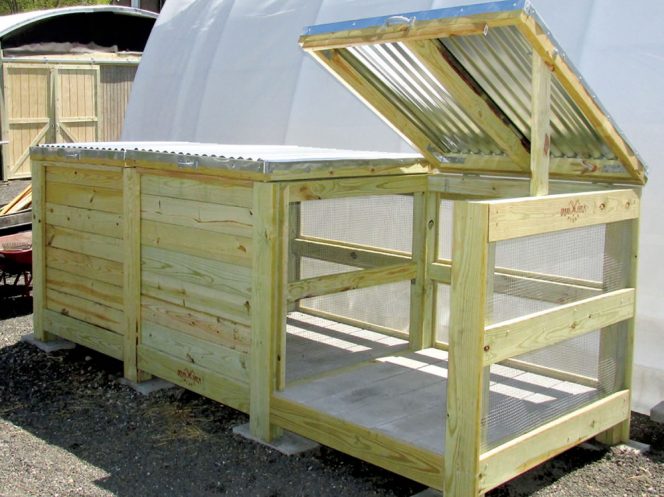BioCycle May 2017
Royersford, Pennsylvania: Pale Ale, With Boost From Compost
Ned Foley, owner of the Two Particular Acres composting facility and farm in Royersford, just let BioCycle know that his strategy to sell compost “one pint at a time” is bearing “fruit,” or we should say pale ale, is available at our local Wegmans Food Market Pub. Starting on Earth Day, April 22, select Wegmans Pub locations feature Sly Fox’s Circle of Progress Pale Ale, a sustainable, special edition, small batch brew made from barley malt composted with Wegmans food scraps at Two Particular Acres. Wegmans partners with Two Particular Acres to compost food scraps from nine of its stores, totaling nearly 3 million pounds in 2016. Compost is used to fertilize Foley’s crops, including barley. Two years ago, Foley, a craft beer enthusiast, was looking for an outlet to get his barley malted when Tim Ohst from Sly Fox Brewing Company introduced him to Alan Gladish at Double Eagle Malt, a micromalting operation in Huntingdon Valley, Pennsylvania. The two began collaborating, which sparked an idea for Ohst and Foley — crafting a beer that uses only local malt. And Circle of Progress was born.
“Growing barley for craft brewers is our way of helping the larger community understand the real value of composting and organics diversion,” explains Foley. “Sly Fox, Double Eagle Malt and Wegmans all understand the value to the community and we are extremely proud to partner with each of them to ‘spread the gospel’ of compost, one pint at a time.” He adds that the barley used for each pint of Circle of Progress was grown using just over three pounds of compost. Currently, 75 Wegmans stores have programs in place that divert food scraps from landfills by offering them as feed for local livestock, or sending them for composting or anaerobic digestion.
Washington, DC: District Ramps Up Composting, Food Waste Diversion
As part of an overall goal to ultimately divert 80 percent of its solid waste, the nation’s capital has rapidly expanded its community composting and food waste drop-off infrastructure, while educating residents on those and other solid waste diversion matters. In its first Solid Waste Diversion Progress Report issued in 5 years, the Washington, DC Department of Public Works’ (DPW) new Office of Waste Diversion (OWD) reported that, at the end of 2016, the Department of Parks and Recreation (DPR) had installed 50 critter- and smell-proof community composting bins designed by Urban Farm Plans, each with one ton/month capacity. All 50 should be in use by the end of September 2017, notes Annie White, OWD manager. The DPR created the Community Compost Cooperative Network to help “responsibly create high quality compost.” To join, each member must take an hour training and help volunteer for one hour each month.
The DC Public School System provides cafeteria composting in 39 out of 120 DC public schools, which it continues to expand. In April, OWD launched its Food Waste Drop-off program, which features a year-round food waste drop-off site in each of its eight wards, typically at farmers markets or metro stops, which will be open one day a week. OWD expects to get 75 to 100 participants per site every week.
“The District will probably have more community composting and food waste drop-off locations per capita than any other municipality in the U.S.,” notes White. But with only 4.83 percent of its residential waste stream going to composting, many of OWD’s initiatives have focused on educating DC residents about food waste. The District engaged the 12,000 attendees to the 2016 Kingman Island Music Festival in food waste diversion for the first time, collecting it for composting and making sure that food trucks had either recyclable or compostable packaging. It expects to repeat the program this year. A “Feeding the 5000” event in May 2016, which served 6,750 people free meals sourced from fresh produce that would otherwise have been wasted, got national news coverage.
The DC Departments of Energy and Environment, General Services, and the DC Housing Authority also completed a pilot program for recycling education in public housing and did waste audits on three such properties, revealing that 80 percent of those waste streams was either recyclable or compostable. “We started education and outreach on waste prevention, with how to reduce household waste, such as opting out of junk mail catalogs, food waste, and grass cycling [leaving clippings on the lawn],” says White. A study outlining the feasibility of curbside organics collection is expected soon.
Marin County, California: Soil-To-Soil Textile Production
Fibershed began in 2010 with a commitment by its founder, Rebecca Burgess, to develop and wear a prototype wardrobe where the dyes, fibers and labor were sourced from a region no larger than 150 miles from the project’s headquarters in the San Geronimo Valley in Marin County. The goal was to show that regionally grown fibers, natural dyes, and local talent were still in great enough existence to provide a basic human necessity — clothes. Within months, the project became a movement, and Burgess founded Fibershed’s 501c3 to address and educate the public on the environmental, economic and social benefits of decentralizing the textile supply chain.
Fibershed develops regional and regenerative fiber systems on behalf of independent working producers, by expanding opportunities to implement carbon farming and rebuild regional manufacturing, and through connecting end users to farms and ranches through public education. “We envision an international system of regional textile communities that enliven connection and ownership of ‘soil-to-soil’ textile processes, which includes composting,” explains Burgess. “These diverse textile cultures are designed to build soil carbon stocks on the working landscapes on which they depend, while directly enhancing the strength of regional economies. Through strategic grazing, conservation tillage, compost application, and a host of scientifically vetted soil carbon enhancing practices, our supply chains will create ‘climate beneficial’ clothing.”












